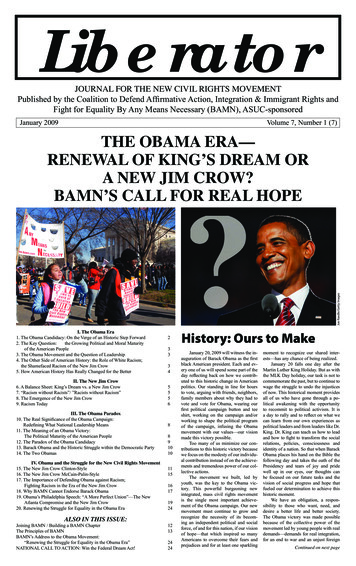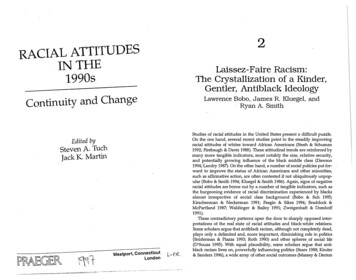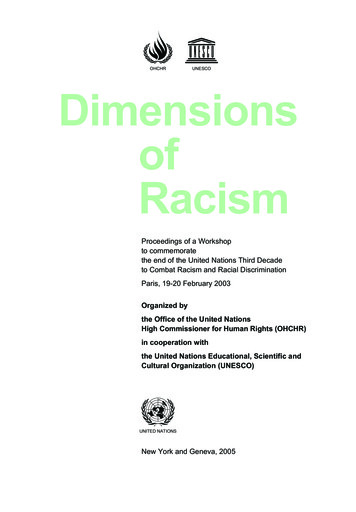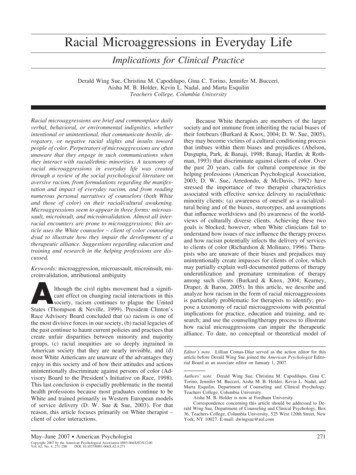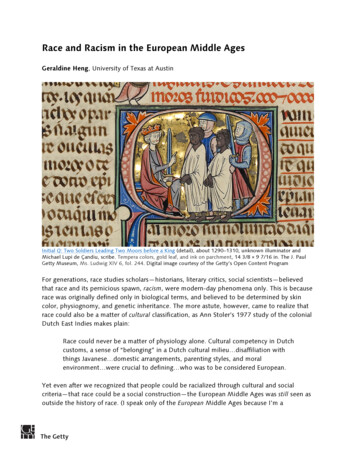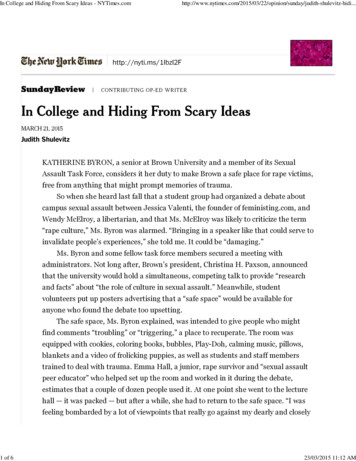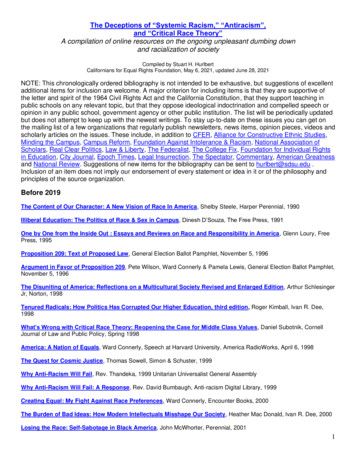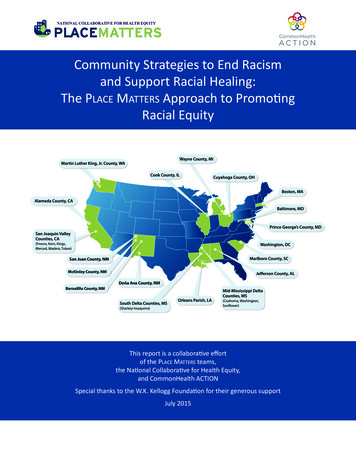
Transcription
Community Strategies to End Racismand Support Racial Healing:The PLACE MATTERS Approach to PromotingRacial EquitySan Juan County, NMMcKinley County, NMDoña Ana County, NMBernalillo County, NMThis report is a collaborative effortof the PLACE MATTERS teams,the National Collaborative for Health Equity,and CommonHealth ACTIONSpecial thanks to the W.K. Kellogg Foundation for their generous supportJuly 2015
PrefaceThis document outlines some of the experiences of leaders working through the PLACE MATTERS initiative tocreate racially just and equitable communities as part of their broader work to eliminate racial and ethnic healthinequities. While many other community-based initiatives have been developed over the years to address theseinequities, PLACE MATTERS is distinguished by its central focus on undoing both racism and its consequences forthe health and well-being of people of color.Established in 2006, PLACE MATTERS seeks to help build the capacity of leaders and communities around thecountry to identify and address the social, economic, and environmental factors that shape health. As a result ofresidential and workplace segregation and other forms of racism, many people of color find themselvesrelegated to spaces and places that host a heavy concentration of health risks, while lacking geographic and/orfinancial access to health-enhancing resources, relative to wealthier and whiter communities. For example,communities of color disproportionately fall among federally designated “food deserts,” communities where itis difficult to access nutritious, high-quality, affordable foods. These same communities are much more likely tobe overrun with environmental health threats, such as air, water, and soil pollution. They are more likely thanwealthier and whiter communities to lack safe, reliable public transportation, housing, and other amenities. Andthey are less likely to benefit from the basic structures necessary for economic security and mobility, such aswell-paying jobs, fair mortgage products, and opportunities to access capital to start a business or purchase ahome.These inequities are not an accident. They are the result of policies and practices that disadvantage and marginalize communities of color – and not necessarily with conscious, malevolent intent. Some of these inequities arethe result of our nation’s failure to correct historical injustices, such as Jim Crow segregation and discrimination, which left many communities of color disadvantaged relative to white communities and whose rippleeffects are still felt today across many generations. Others are the result of institutional practices and structuresthat continue to disadvantage communities of color, despite being facially “race neutral.” These include schooland residential segregation, much of which is maintained by discrimination and implicit biases, which lie belowthe level of conscious awareness and are automatically activated when we encounter difference. Studies showthat the vast majority of Americans – including a sizeable percentage of people of color – harbor these implicitbiases, which affect our daily thoughts, behaviors, and actions in ways that result in poorer treatment of peopleof color.This “blueprint” – one of a series that PLACE MATTERS teams will release – documents the learning of PLACEMATTERS teams who seek to directly confront racism and build public will for its elimination. While manyPLACE MATTERS leaders contributed to this document, three deserve special recognition for their dedicated workto construct this blueprint: Paula Harris-White, Diversity Manager for King County (WA); John Capitman,Executive Director, Central Valley Health Policy Institute and Professor of Public Health at the California StateUniversity at Fresno; and Gregory Townsend, Chair of the Birmingham (AL) Metro Diversity Coalition andHealth Service Administrator with the Jefferson County Department of Health.We hope you find this blueprint useful as you work to create more equitable, more just communities.Community Strategies to End Racism and Support Racial Healing1
Community Strategies to End Racism and Support Racial HealingThe Racism and Racial Healing Blueprinting Workgroup is pleased to share the following Blueprint withindividuals and groups in active pursuit of eliminating racial and ethnic inequities in our communities. Itscontents reflect a collaborative effort on the part of individuals participating in the“A vigorous enforcement of civilnational PLACE MATTERS initiative. We base the frameworks and suggestedrights will bring an end to segregatedapproaches on our collective experience working in a wide variety of communitiespublic facilities, but it cannot bringin different regions of the United States. We recognize the challenges of this workan end to fears, prejudice, pride, andirrationality, which are the barriersand offer our encouragement to those embarking on a similar journey.to a truly integrated society.”Martin Luther King, Jr. (1967)Our experience as PLACE MATTERS communities has been that individual racismand internalized racism are among the key barriers to community-levelproblem-solving and the engagement of all needed participants in community change initiatives. Ending racismand promoting racial healing is just one of the key strategic frames that PLACE MATTERS communities areadopting, along with the approaches being addressed in other blueprints, including: Moving a community from cohesion to mobilization; Mobilizing communities for healthy and successful youth; and Making a successful case that “PLACE MATTERS” to policymakers, and influencing equitable policy.Too often we allow fear to paralyze action specifically focused on healing the divisions that fuel racism, and wedefault to implementing well-meaning but limited programs; such efforts are simply powerless in creatingeffective and sustained improvements, because racism remains a root cause of many of the racial inequities inU.S. communities.PROBLEM STATEMENTThe U.S. population is living longer than ever before, with life expectancy on average approaching 79 years.However, many people of color experience poorer health relative to whites across the life cycle, beginning atbirth with higher rates of infant mortality, and proceeding through childhood, adolescence, and adulthood withhigher rates of chronic and infectious diseases, and concluding at the end of the life cycle with higher rates ofpremature mortality. These inequities cannot be attributed to genetics or behavior. Racism operates at severallevels – cultural, institutional, interpersonal, and personal. These factors, described in more detail below,significantly shape health inequities throughout the United States.Racism harms all people by devaluing and separating them from each other. It denies people of color equalaccess to benefits, privileges, and power, while providing whites with greater access to opportunities in manyaspects of life. This results in people of color living in a world where opportunity is limited and curtailedbecause of the color of their skin. They have higher and disproportionate rates of incarceration, but lower ratesof educational attainment, access to wealth, and home ownership. They are more likely to be born aslow-weight babies, they are born burdened by the racism that will permeate their lives, and they are more likelyto die early. During their lives, they will experience disproportionate health burdens, such as higher rates ofdiabetes, high-blood pressure, and sexually transmitted diseases.Racism forms a major factor in success and well-being in the United States, and throughout our history somegroups (e.g., whites) have been defined as worthy of full inclusion while others, such as African Americans,Latinos, American Indians /Alaska Natives, Southeast Asians, Pacific Islanders, and others in communities ofCommunity Strategies to End Racism and Support Racial Healing2
color have been devalued and disadvantaged by policy and culture. Racism is expressed in multiple ways thatreinforce each other: at the personal and interpersonal levels individual feelings, beliefs, and interactionsexpress negative evaluations of historically excluded groups; at the cultural level, the beliefs of historicallyincluded groups about what is right and beautiful are imposed on others; and at the structural/institutionallevel, explicit and implicit laws, rules, and expectations of public and private institutions and systems advantagehistorically included groups while disadvantaging excluded groups. At the personal and interpersonal levels,members of historically included groups may express explicit and/or unconscious bias and prejudice towardcommunities of color, while persons in historically excluded groups may internalize negative views of their owngroup. Emerging research in cognition and brain science has shown how intergenerational exposure to racismand ongoing discomfort in multiracial encounters are expressed both as implicit bias and dynamic physiologicalresponses. The expressions of racism have expanded over time and include both old-fashioned racism thatjustifies policies of racial/ethnic advantage by claiming the superiority of historically included groups; andmodern racism that offers nonracial justifications for policies that nonetheless disadvantage historicallyexcluded groups.As participants in PLACE MATTERS, we are seeking to improve life outcomes for people of color and otherlow-income residents of communities disproportionately impacted by racism and other systemic inequities. Wehave found that successful adoption of the social-determinants-of-health frame and place-based approach to theelimination of health inequities requires communities to directly address theHealth inequality is the generic termlegacy and enduring consequences of racism operating at multiple levels.used to designate differences,Experiences and scholarly work throughout the U.S. have indicated that, without variations, and disparities in thedirectly addressing racism and other systemic inequities, communities remainhealth outcome of individuals andunable to move from dialogue to a place of innovative policymaking andgroups.constructive change toward racial equity. We urge all communities to addressHealth inequality refers to thosethe roles of racism and privilege in their communities.inequalities in health that are theresult of injustice and are avoidableor unnecessary.Additionally, racism is the “canary in the coal mine.” Because racial/ethnicinequities and the systemic factors that create and sustain these inequities areperhaps the most observable forms of oppression, assisting individuals and communities in addressing racism isa key strategy in addressing other forms of oppression, sexism, classism, homophobia, and ethnocentrism.Racism cuts across, and is imbedded in or layered into, all other forms of oppression. When it is addressed,society is improved for all oppressed groups.As PLACE MATTERS communities, our work is based on the accumulating scientific literature that shows howracial/ethnic and social class inequities in health and other life outcomes are determined directly by macro- andindividual-level neighborhood characteristics and indirectly by the historic and current policies and practicesthat shape living conditions. Further, our national and local work reflects the belief that these socialdeterminants of health are the concrete expressions of historical and current racism and other systemicoppression in our communities. There has been much less consensus among our communities about the role ofeducational efforts focused on changing individual race-relevant attitudes, beliefs, and behaviors in addressinginequities in the social determinants of health. For example, some PLACE MATTERS communities haveemphasized broadening public awareness of local histories of systematic exclusion. As a result, the similaritiesand differences in the strategies adopted and accomplishments attained across PLACE MATTERS communitiesoffer a national laboratory in which to understand how communities can lead the way in supporting andpromoting racial equity.Community Strategies to End Racism and Support Racial Healing3
Despite these differences in emphasis, PLACE MATTERS teams believe that: Communities should be equipped and prepared to catalyze, facilitate, and sustain efforts towardachieving racial equity and healing; Communities can develop the will and successful approaches that effectively address and mitigate theeffects of racism on institutions, neighborhoods, and individuals; Communities should identify and build diverse coalitions to abolish institutional policies and practicesthat create and sustain racial inequity; and, Communities should mobilize resources to reduce racial bias and promote racial healing usinginnovative and effective approaches toward reducing the effects of racism at a place-based level.THEORY OF CHANGEEducational initiatives around racism as the root cause of health inequalities have as their goals ending racismand promoting racial healing. To meet these goals, individuals and communities need to understand and havetools to address the multiple forms of racism, their differential impacts, and how they connect to each other.These initiatives also seek to help individuals acquire knowledge about how institutional and structural racismhas evolved over time and become an almost accepted part of societal life. This understanding needs to extendto internalized racism and how it results from the deeply ingrained history of oppression in our society.Internalized racism reinforces structural and institutional racism, and ultimately supports systems of inequity.Anti-racism education helps individuals become aware of personal/interpersonal expressions of racism, offersan understanding of the historical and political context of racism, and helps people understand how the currentclimate of racism came to be. In the context of anti-racism education, individuals also have the opportunity toexplore alternative solutionsFocus of Change Strategiesto the social determinants ofinequity.Personal:Interpersonal:As this illustration fromVisions, Inc. indicates, racismand other forms of oppressionare expressed at four levels.The different expressions ofoppression are mutuallyreinforcing and, consequently,each of these levels needs tobe addressed in order toinfluence and implementchange (source:http://visions-inc.org/).Aim is to change thoughts andfeelings; increase awareness andopenness to learningAim is to enhance skills,communication pattersn; impactbehavior and relationshipsInstitutional:Cultural:Aim is to identify structural barriersand create policies, practices,programs and policies that supportequitable outcomes.Aim is to create environmentsrepresentative of and welcoming tothe organization’s diversity;celebrate and utilize differences.We have learned in our PLACE MATTERS work that there are a variety of anti-racism efforts going on in eachcommunity. We encourage a collaborative and cohesive effort to end racism at all the four levels shown in thediagram. The focus cannot only be on the interpersonal level, but must also be applied, by those who have thetools and access, within the structures and institutions that keep racism and privilege in place. As part of theefforts to dismantle these structures, individuals and communities must first understand the system, how andwhy it was set up, how it evolved, and how it can be dismantled. While there are numerous approaches toaddressing racism on all levels, this blueprint’s theory of change encapsulates the PLACE MATTERS approach thatbuilds on individual perspective transformation to ultimately achieve community and societal transformation.Community Strategies to End Racism and Support Racial Healing4
DESCRIPTIONBased on our experiences as PLACE MATTERS communities and on reviews of other efforts, we believe thatcommunity strategies to end structural/institutional racism and support racial healing and place-based initiativesto address racial/ethnic inequities are mutually supportive. Because inequities are one consequence of structuredracial inequalities, place-based efforts to change policies, programs, and environments that create and sustaininequities can be facilitated by community strategies to end structural/institutional racism and promote racialhealing. Community members serve as the foundation for this theory of change. Community members must firstexperience a perspective transformation – a change of heart and new ways of understanding – and then workwith the rest of the community to break down/dismantle structurally and institutionally racist systems, with thegoal of ultimately promoting and supporting racial healing. Our experiences suggest at least nine specificfeatures of initiatives to end structural/institutional racism and promote racial healing in support of addressingracial/ethnic health and other inequities. These features of place-based initiatives to transform perspectives arereflected in the figure and described below.Acknowledge thecentrality ofracial hierarchiesHoldinstitutionsaccountableUse effectivecommunitytools andstrategiesAcknowledgethe centrality ofblack-whitedynamicsInitiative to EndRacism andSupport RacialHealingAddress theroles of whitesin a racializedsocietyExplore/address racismwithin the t tolong-termorganizing andadvocacyCommunity Strategies to End Racism and Support Racial HealingDiscuss racismand privilegeusing diverseleadership5
Community Actions to End Structural/ Institutional Racism and PromoteRacial Healing1. Use effective community tools and strategies. Effective strategies identify structural racism as the rootcause of race and place-based inequities. Effective strategies focus on race as a social rather than biologicalconstruct and promote the understanding of intersections among race, ethnicity, class, sexual orientation, andgender. Effective strategies that end racism and promote racial healing provide participants with a cognitive andaffective understanding of the cultural, structural, institutional, and political aspects of racism and thedevelopment of skills in working effectively.For example, the Cook County (IL) PLACE MATTERS team has offered presentations on health equity in a diverserange of community settings. These presentations have proven to be a powerful tool for building the base ofcommunity organizations and residents interested in creating a health equity movement. They feature an explicitdiscussion of structural racism and power imbalances as determining an unfair distribution of resources.Similarly, as a result of the King County (WA) Equity and Social Justice Ordinance (described in more detailbelow), the King County Department of Public Health has implemented “Countering Bias” training for personsinvolved in all hiring decisions. The training provides statistical data on agency applicants and hires,information on implicit bias and the impact it can have on hiring, and measures to counter it.2. Feature community dialogue that includes all groups – not just people of color – and draw on anexplicit framing of how structural and personal-level racism creates and sustains inequities. We cannotassume that all people of color have the same views or experiences regarding racism. Time must be set aside forintragroup dialogues as well as cross-racial/ethnic group dialogues on racism and privilege.For example, the Birmingham (AL) Metro Diversity Coalition, which started in 2006, is a coalition of diversepartners from a number of organizations that have come together “to serve as a catalyst for one communityliving in harmony.” The group focuses on constructive dialogue and consensus building as tools to promotehuman dignity and equality. The partners recognize and target the social determinants of health as key to therealization of a community without racism. Inequalities in education, employment, housing, income, and healthcare access are recognized as key hurdles to achieving sustained racial healing. Further, they acknowledge andappreciate the deep fissures of wounds left from this city’s civil rights struggles and the slow and painfulprocess of healing; they also know how easily these wounds can be re-opened.3. Include learning processes that explore how whites learn their roles in a racialized society and the costsof adhering to these roles. Opportunities need to be available for white communities to explore their ownexperiences of privilege and racial superiority through facilitated dialogue, and how whites view theirresponsibility to address race and place-based inequities.For example, the Boston Public Health Commission has featured “undoing racism” workshops across the city aspart of its multipronged approach to address racial/ethnic health inequities. The workshops offer opportunitiesfor white participants to explore how “personally mediated” racism has evolved and how their own experiencesmay reflect this. The workshops emphasize the key role of personally mediated racism in sustaining whiteprivileges and institutional structures that allow for less opportunity for communities of color. Similarly, boththe San Joaquin Valley (CA) counties and Cook County Public Health have noted the difficulty engaging whitecommunities in dialogue about privilege and racial superiority and the potential contributions of thesediscussions to addressing health and other disparities. These PLACE MATTERS teams both report that they havecreated opportunities for people to learn about racism together and develop meaningful, enduring personalCommunity Strategies to End Racism and Support Racial Healing6
relationships across lines of difference. Participants report an increased understanding of how racism stillimpedes individual opportunity and community well-being.4. Include a full discussion of all groups that experience structural barriers to health and well-being byacknowledging the centrality of racial hierarchy as the basic framework for structured inequality in theUnited States by both acknowledging how black-white dynamics have provided the basic framework forstructured inequality in the US and exploring the unique experiences of oppression for other racial/ethnicgroups. It is important that this dialogue begin intragroup, before moving out to include other racial and ethnicgroups. Issues of internalized racism and privilege must be discussed internally before a meaningful externaldialogue between diverse communities can take place.In 2011, King County began offering training for employees on racial micro-aggressions in the workplace. By2012 it had launched a series of “Lunch & Learn” events for employees on topics such as “What Does It Meanto Be White: Developing White Racial Literacy”; “Asian Americans and the Movement for Racial Justice”; and“Beyond Diversity: Native American Leadership and Marginalization.” In 2014, training on the history ofracism and how it has impacted people of color and whites was developed for and delivered to employees; thepresentation included the documentary film, “Race: The Power of an Illusion.”5. Explore ways to hold institutions accountable for measuring racism and unearned privilege. This oftenrequires engaging institutional leaders and staff in dialogue about racism, white privilege, and the roles of theinstitution in creating and sustaining racial/ethnic inequities. Additional work must be done by these institutionsto assess and evaluate “race-neutral” policies and practices that result in negative outcomes for communities ofcolor. Communities must hold institutions accountable for identifying these practices and policies, evaluatingand assessing the impact, and determining what steps they will take to end the practice or policy and/or mitigatethe negative impact.For example, in 2008, the King County Executive decided to take a bold move to address the inequities in KingCounty. The Equity and Social Justice (ESJ) Initiative, launched in early 2008, required all executivedepartments to make equity and social justice central to their work. This resulted in three levels of action: policydevelopment and decision-making, internal organizational practices, and community engagement. Everydepartment was required to make a series of annual ESJ commitments indicating the actions it would take toaddress inequities. By 2010, King County had enacted an ordinance requiring equity and social justice impactsto be considered in all county projects. Departments and agencies are required to make annual commitments toaddressing and eliminating inequities in areas such as employment, contracting, and budgetarydecision-making.In Ohio, the Health Improvement Partnership-Cuyahoga (HIP-C) (http://www.hipcuyahoga.org) is developing acommunity health improvement plan (CHIP) grounded in equity. It is based on local data and being developedwith meaningful input from community residents for strategic direction, action plans, and measureableoutcomes. The Cuyahoga County PLACE MATTERS team (http://cuyahogaplacematters.com) was instrumental inthe selection of “Eliminating Racism as a Social Determinant of Health” as one of the four key priorities.Partners working to address this priority hope to achieve perspective transformation that will change the waypeople in Cuyahoga County think and feel about structural and institutional racism. In turn, this changedperspective will impact the policy environment at the county level and through organizations that provideleadership and services across the county. This will lead to improved health opportunities for all residents ofCuyahoga County.Community Strategies to End Racism and Support Racial Healing7
6. Include a focus on political and economic power, with the goal of shifting power toward proponents ofracial and ethnic equity. Understanding the processes by which some groups are privileged and others aredenied opportunity is key to shifting power from the dominant group. Specifically documenting how policiesand programs create unexamined and unearned privilege for whites and helping individuals to understand howthese privileges have played out in their own lives are key steps in promoting such a shift in power. It may behelpful to explore how unexamined privileges are sustained by feelings of racial supremacy.For example, the Boston initiative has highlighted the importance of understanding structural racism in terms ofpolitical and economic power, and a key component of the initiative’s training activities has been to focus onhow privilege is created, maintained, and interrupted. In Birmingham’s struggle to keep open the public hospitalserving low-income communities of color, a key element of the debate has been to focus on the unexamined andunearned health care access advantage enjoyed by white residents. In the San Joaquin Valley workshops there isan explicit focus on the role of white supremacy feelings in the historic violence in and current adamantopposition to farm labor organizing.7. Uncover and share local information on specific policies, practices, and environments. Promoting adetailed understanding of how communities become healthy and unhealthy places and the role of racism andprivilege in this process is a necessary component of effective strategies to reduce bias and promote healing. Ineach community, there is a specific local history of how the policies, practices, and environments were formed.This history can show how local conditions – the local expression of societal racism – create and sustain healthand other inequities. Community members need to be engaged in developing an inventory of the current localpolicies and practices that continue rather than interrupt the legacy of place-based inequalities. Developingconsensus on which of these is most actionable can be a starting place for community mobilization. Programfacilitators need to commit to teaching the long-term history of racism and privilege in the community, tyingthat history to current circumstances, and directly addressing the tendency to attribute negative health and otheroutcomes exclusively to individual choices. Government officials must, in turn, be committed to listening to thecommunity, being accountable, and instituting actual changes. In many communities, there is a history of lackof accountability to equity advocates and traditionally excluded communities. Institutional representatives mayneed to spend time rebuilding trust and relationships in the process of increasing community engagement.For example, the Jefferson County PLACE MATTERS team is building support for eliminating racism by workingwith city leaders to identify key levers for policy change and/or development strategies to promote health andhealth equity in city planning. It is currently engaging grassroots community members to bring to theirunderstanding a focus on promoting health policies. A central theme has been the unwillingness of the city’sleadership to re-examine policies, prioritize improving services and increasing funding in historically AfricanAmerican communities. Also, in the context of the 50th anniversary of the 1963 civil rights events inBirmingham, important work to improve differences in poverty, food access, life expectancy, and infantmortality in certain census tracts is under way. The team’s report (www.jeffcoplacematters.com) is being used toadvance knowledge for promoting equity in planning and zoning policies, and it offers recommendations forimproving health and reducing the health inequity that is embedded throughout the city’s past comprehensiveplans (see www.birminghamcomprehensiveplan.com/).In Seattle, the Racial and Social Justice Initiative has used an internal community organizing strategy since2004 that features ongoing educational efforts. One such effort, the Racial Equity Toolkit, guides employees toincor
responses. The expressions of racism have expanded over time and include both old-fashioned racism that justifies policies of racial/ethnic advantage by claiming the superiority of historically included groups; and modern racism that offers nonracial justifications for policies that nonetheless disadvantage historically excluded groups.
